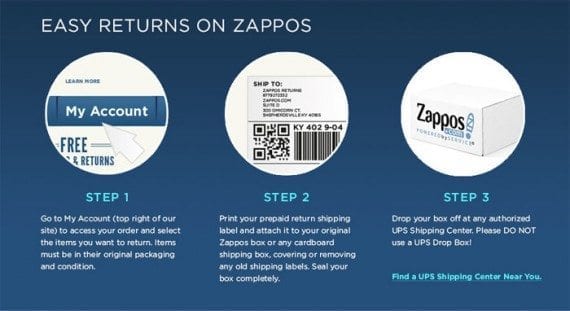Shoppers have generally come to expect online stores to offer returns, refunds, and exchanges for items that are defective, damaged, or otherwise not as expected. And when retailers don’t have a liberal return policy, some shoppers may simply choose to make purchases on another site.
Returns, however, can be expensive, especially for small online sellers. There can be a real temptation to charge for return shipping, restocking, or to simply refuse to take returns altogether. But these choices are probably not good for growing an online retail business.
Instead, try to build a better ecommerce return policy.
Return Policy a Long-term Business Decision
The first step toward building, if you will, a better return policy is to remember that how your business treats returns should be part of a long-term strategy aimed at developing repeat customers.
… how your business treats returns should be part of a long-term strategy aimed at developing repeat customers.
Loyal, repeat customers are significantly more valuable than new customers in at least three ways.
First, there is a lower acquisition cost associated with purchases from repeat shoppers. To get a shopper to visit an online store for the first time, many online merchants invest heavily in pay-per-click advertising, other online advertising, social media marketing, search engine optimization, and more. In contrast, loyal customers often return to a merchant’s website of their own accord or in response to an email marketing message, which is much less expensive.
Second, an Internet retailer’s repeat customers will typically spend more each time they make a purchase.
In a 2012 study, “The ROI from Marketing to Existing Online Customers,” Adobe found that returning customers, those who come back for a second purchase, and repeating customers, those who come back for three or more purchases, send three times and five times more, respectively, than a new customer will on each purchase.
In fact, according to the 2012 Adobe study, a new customer in the United States will produce about $2.06 in revenue per visit, a returning visitor coming back for a second purchase will produce something like $5.22 in revenue per visit, and the repeat customer coming back for three or more purchases will produce about $10.24 in revenue per visit.
Third, a retailer’s loyal customers will spend more over time, since they return again and again.
Free and Easy Returns Drives Repeat Buyers
So what does this have to do with creating a better return policy? Offering free and easy returns may help an online retail business build lasting relationships with repeating customers, while a return policy that restricts customers or charges them, can inhibit and harm customer relationships.
Offering free and easy returns may help an online retail business build lasting relationships with repeating customers…
In 2008, United Parcel Service commissioned a Forrester Research study titled “Crafting a Returns Policy that Creates a Competitive Advantage Online.” This study found that 81 percent of respondents would be relatively more loyal to online retailers that offered free, no-questions asked returns, and that 73 percent of respondents would be less likely to purchase from a retailer again if returning an item was a hassle.
Similarly, a 2012 Washington and Lee University study reported that shoppers who had received a free return from an online retailer would increase their purchases with that retailer at least 58 percent and as much as 357 percent over a 2-year period.
Unfortunately, when shoppers were charged for a return, their future purchases dropped at least 74 percent and in many cases they would not return at all.
With this information as background, try to map out how your retail business will treat returns. How long after a purchase should a customer be able to return an item? Do some items have different return policies than other items? Are there times when you simply refund a purchase and let the customer keep the items?
Finally, be certain to measure your return policy’s success. Do customers with a return experience tend to return and make additional purchases, or not?
Return Policy Should be Written for Customers, Not Lawyers
Once an Internet retailer has decided on its customer-winning return policy, it needs to communicate that policy to shoppers in a clear way. Unfortunately, it is easy to produce return policy descriptions that seem like they were written by a lawyer for other lawyers. But, ultimately, a written return policy should be for customers, not the legal system.
Online retailer Zappos, as an example, offers an easy-to-understand return policy.
Aim for a Hassle-free Customer Experience
Finally, an online retailer’s return policy is only good if returning an item is actually easy and hassle-free. In many cases, this has more to do with infrastructure and software. How does a shopper initiate a return? How is the shipping label managed? How long will refunds take to process?
Here again, Zappos serves as a good example.






